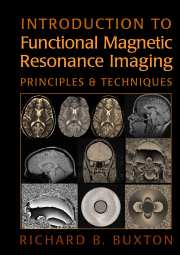14 - Contrast Agent Techniques
from IIIA - Perfusion Imaging
Published online by Cambridge University Press: 05 September 2013
Summary
BOLUS TRACKING STUDIES
The Beginning of fMRI
In clinical magnetic resonance imaging (MRI) studies contrast agents are used to alter local relaxation times (Lauffer, 1996). Gadolinium-DTPA is the most commonly used contrast agent. Gadolinium (Gd) is a lanthanide metal ion with the unique property of having seven unpaired electrons. In most atoms, electrons in an orbital pair up with opposite spin so that the net magnetic moment due to the electrons is zero. Unpaired electrons create a strong, fluctuating magnetic field in their vicinity that promotes relaxation of nuclear magnetic moments. When gadolinium reaches a tissue water pool, the T of the local water protons is reduced, increasing the signal in a T-weighted image. In the healthy brain, Gd-DTPA does not cross the blood brain barrier, and because the agent remains confined to the vasculature, there is little relaxivity effect. The T of the intravascular component is reduced, so the blood signal increases, but the extravascular spins are unaffected. The typical blood volume in brain tissue is only about 4%, so the net signal increase due to the presence of gadolinium is small. But in a tumor with leaky capillaries, the gadolinium readily diffuses into the extravascular space, and the tumor enhances on the magnetic resonance (MR) image.
In the late 1980s, Villringer and co-workers discovered an additional effect of gadolinium that forms the basis for using contrast agents in functional magnetic resonance imaging (fMRI) (Villringer et al., 1988). By observing the healthy brain with rapid dynamic MRI, they were able to track the bolus of Gd-DTPA as it passed through the brain in a rat model.
Information
- Type
- Chapter
- Information
- Introduction to Functional Magnetic Resonance ImagingPrinciples and Techniques, pp. 330 - 350Publisher: Cambridge University PressPrint publication year: 2002
